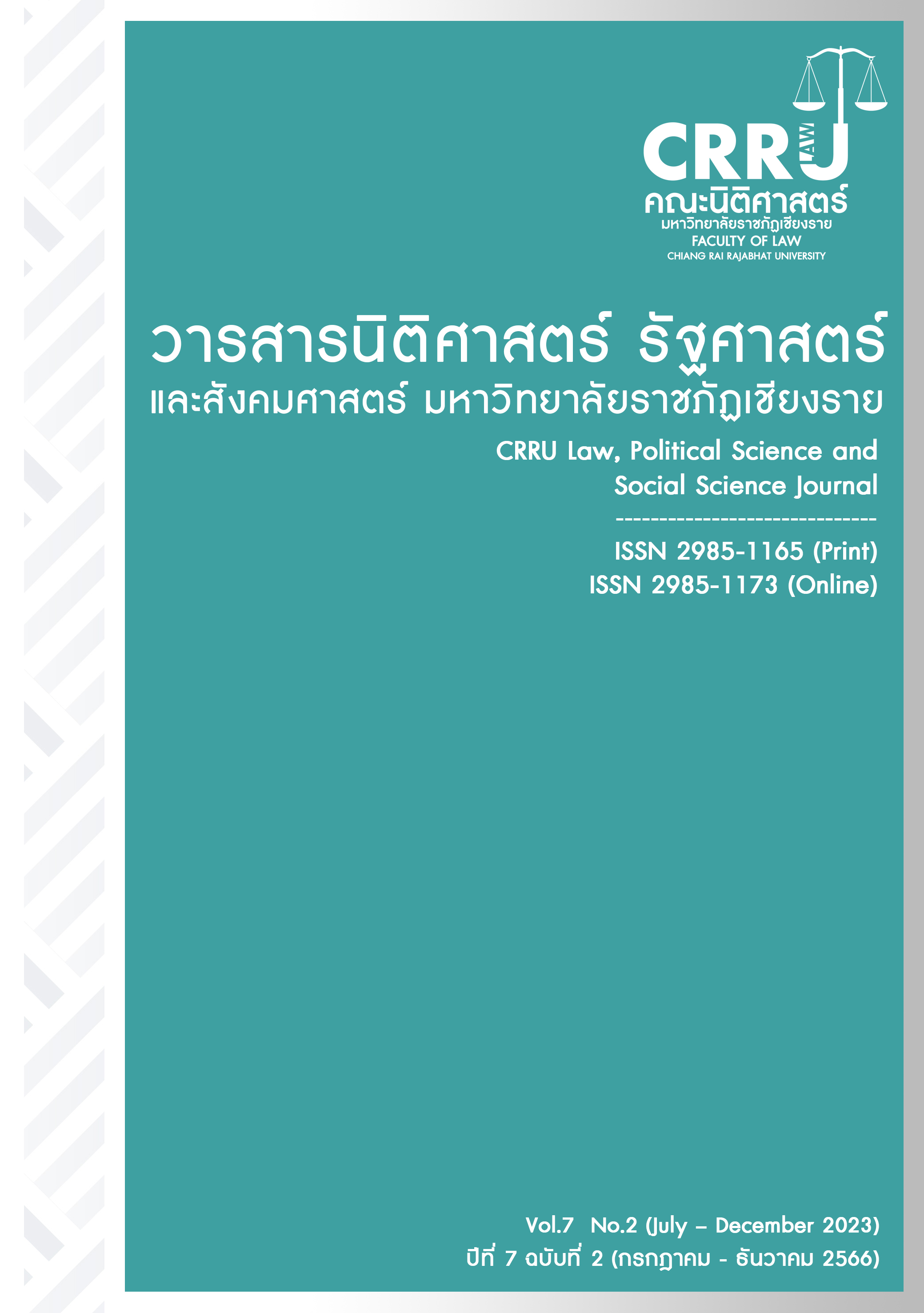Legal Problems Regarding Human Remain Management with Environmental Impact
Main Article Content
Abstract
The study has found that for cases of burial, the issues with local regulations identified include the methods of burial in accordance with local ordinances leading to inefficient land use and the permanent utilization of land for burial purposes, which does not maximize the land's potential benefits. Moreover, the local regulations allow for the inclusion of wooden coffins in the burial, which do not decompose easily, thus not maximizing the wood's potential benefits. For cases of cremation, the local regulations do not specifically stipulate the particular features of cremation furnaces, such as the number of burning chambers required. Additionally, the local regulations lack provisions regarding the separation of materials that should not be burned prior to the cremation process and do not impose prohibitions or conditions concerning the inclusion of additional items during the cremation process. Consequently, these factors contribute to increase the likelihood of air pollution resulting from such cremation.
At any rate, it is anticipated that the number of deaths in our world will increase. Consequently, the human remain management in accordance with the law, whether by means of burial or cremation, has an impact on the environment. If there is an amendment or addition to the provisions in the law to clarify the methods of human remain management or adding alternative human remain management using environmentally friendly human remain management practices, it will transform human remain management in the country into an activity that utilizes natural resources efficiently, is cost-effective, and reduces environmental damage.
Article Details
References
กรมควบคุมมลพิษ. “หลักเกณฑ์การยกระดับมาตรฐานเตาเผาศพ.” 2563. https://bit.ly/3pddFsE. สืบค้นเมื่อ 6 มกราคม 2566.
กรมส่งเสริมการปกครองท้องถิ่น กระทรวงมหาดไทย. มาตรฐานสุสานและฌาปนสถาน. 9. https://dcstore.phsmun.go.th/test02/file_data/201509101057491.pdf. สืบค้นเมื่อ 12 มกราคม 2566.
กรมส่งเสริมคุณภาพสิ่งแวดล้อม. “ฌาปนกิจแบบลดมลพิษ เป็นมิตรกับโลก.” 2564. http://eservice.deqp.go.th:6699/news/view/8899. สืบค้นเมื่อ 2 มกราคม 2566.
กัญจน์ชนก ธรรมวโร. “มาตรการทางกฎหมายในการส่งเสริมการใช้รถยนต์ไฟฟ้าในประเทศไทย.” วิทยานิพนธ์ปริญญามหาบัณฑิต คณะนิติศาสตร์ มหาวิทยาลัยธรรมศาสตร์, 2559.
กัลยา เกียรติถาวรชัย. “การจัดการร่างของผู้วายชนม์แบบเป็นมิตรต่อสิ่งแวดล้อม.” วารสารกฤษฎีกา 1, ตอน 3 (2564): 110. https://www.krisdika.go.th/draft-law. สืบค้นเมื่อ 17 มกราคม 2566.
ชนนาถ ชาติพิชิต. “ความสัมพันธ์ระหว่างการสัมผัสควันจากการเผาศพกับอาการโรคระบบทางเดินหายใจของประชาชนรอบสุสานหายยา จังหวัดเชียงใหม่.” การค้นคว้าแบบอิสระปริญญามหาบัณฑิต คณะสาธารณสุขศาสตร์ มหาวิทยาลัยเชียงใหม่, 2554.
เชิดชาย นันทบุตร. “เตาเผาศพกับมลพิษทางอากาศ.” 2565. http://www.reo14.mnre.go.th/attachment/iu/download.php?WP=qUIcnKt2pQMgZKqCGWOghJstqTgcWatmpQugZap5GQAgG2rDqYyc4Uux. สืบค้นเมื่อ 24 มกราคม 2566.
ณัฐรัตน์ รัตนวิบูลย์สม. “มาตรการทางกฎหมายภาษีสรรพสามิต ภาษีเงินได้นิติบุคคลต่อผู้ประกอบการโรงงานอุตสาหกรรมที่ก่อให้เกิดมลพิษ.” วิทยานิพนธ์ปริญญามหาบัณฑิต คณะนิติศาสตร์ มหาวิทยาลัยธุรกิจบัณฑิตย์, 2554.
เทพพิทักษ์ มณีพงษ์. “ตายแล้ว (จะ) ไปไหน? : 5 วิธีจบชีวิตแบบกรีนๆ ที่ดีต่อโลก.” 2560. https://www.the101.world/green-burial/. สืบค้นเมื่อ 12 มกราคม 2566.
ไทยโพสต์. “คพ.ออกมาตรฐานเตาเผาศพ 4.0 ปี 62 เริ่มปรับวัดใน กทม. ช่วยลดฝุ่นจิ๋ว2.5.” 2562. https://www.thaipost.net/main/detail/25612. สืบค้นเมื่อ 2 มกราคม 2566.
ไทยรัฐ ออนไลน์. “ฝังศพในที่ดินของตัวเอง อาจถูกฟ้องร้องได้.” 2560. https://www.thairath.co.th/news/local/1111849. สืบค้นเมื่อ 1 มกราคม 2566.
ปราโมทย์ ประสาทกุล. “คนไทยมีลูกกันน้อยลง แต่จะตายกันมากขึ้น.” สุทธิปริทัศน์ วารสารวิชาการมหาวิทยาลัยธุรกิจบัณฑิตย์, 19, ฉ.57 (มกราคม-เมษายน 2548): 13. https://so05.tci-thaijo.org/index.php/DPUSuthiparithatJournal/article/view/245830/167141, สืบค้นเมื่อ 25 มกราคม 2566.
ปวิตา ลิขิตเดชาโรจน์. “นักวิจัยชาวเนเธอร์แลนด์พัฒนา “โลงศพมีชีวิต” สำเร็จแล้ว.” 2565. https://www.nsm.or.th/nsm/th/node/14501?fbclid=IwAR33Uu3gqDR5Tsz4wHuHWyWSVLtptvwW3sqmK4j9OZBITH-9JVfKhSeMdJ4. สืบค้นเมื่อ 2 มกราคม 2566.
ภัทราวรรณ รัตนเกษตร และนภนันต์ ศุภศิริพงษ์ชัย. กฎหมายทรัพย์สิน. กรุงเทพฯ: นิติธรรม, 2565.
ภัสน์วจี ศรีสุวรรณ์. “ทำศพแบบคนรักโลก ทำให้เป็นของเหลว.” https://bit.ly/4208Ulq. สืบค้นเมื่อ 25 มกราคม 2566.
ภาณุเมศวร์ บุนนาค. “ประวัติศาสตร์ความตาย.” ใน สัจธรรมชีวิต คู่มือเตรียมความพร้อมกาย ใจ และครอบครัว ก่อนและหลังลมหายใจสุดท้าย, โดย มูลนิธิธรรมาภิบาลทางการแพทย์, 137-138. กรุงเทพฯ: สายธุรกิจโรงพิมพ์ บริษัทอมรินทร์พริ้นติ้ง แอนด์ พับลิซซิ่ง จำกัด(มหาชน), 2564.
วรุณรัตน์ คัทมาตย์. “รู้จัก Human Composting ธุรกิจจัดการ "ศพมนุษย์" ให้เป็นปุ๋ย ตอบโจทย์ยั่งยืน.” 2566. https://www.bangkokbiznews.com/lifestyle/1046125. สืบค้นเมื่อ 16 มกราคม 2566.
Ana Rafaela Ferraz Ferreira. “Body disposal in Portugal: Current practices and potential adoption of alkaline hydrolysis and natural burial as sustainable alternatives.” https://repositorio-aberto.up.pt/bitstream/10216/87894/2/158915.pdf. Accessed January 31, 2023.
BBC NEWS ไทย. “วัดปรับตัวอย่างไรเมื่อต้องคุมมลพิษจากเตาเผาศพ.” 2565. https://bbc.in/41YEGPC. สืบค้นเมื่อ 16 มกราคม 2566.
Beyond. “What Is A Woodland Burial?.” https://beyond.life/help-centre/arranging-a-funeral/what-is-a-woodland-burial/?fbclid=IwAR2AGiytYUPBIQDc6oXmg4e1n1eMPojXwQk0NzkHNjq7-DOj1BzZ8ilYAlE. Accessed January 30, 2023.
Carlton Basmajian and Christopher Coutts. “Planning for the disposal of the dead.” https://diginole.lib.fsu.edu/islandora/object/fsu:207217/datastream/PDF/view?fbclid=IwAR3R2qAGxyIhdAZf1lOFpC6s8eWZkHYU0pmnBo8vLvb6xhMeAysxBRA-xeY. Accessed January 19, 2023.
common team. “‘Capsula Mundi’ โลงศพรักษ์โลก ที่จะทำให้เราเกิดใหม่เป็นต้นไม้.” 2562. https://becommon.co/life/capsula. สืบค้นเมื่อ 30 มกราคม 2566.
Elizabeth Fournier. The GREEN BURIAL GUIDEBOOK. California: New World Library, 2561.
GRID by PEA. “พิธีศพ Eco ด้วยการแช่น้ำสลายร่าง.” 2564. https://www.gridmag.co/alkaline-hydrolysis/?fbclid=IwAR3ehG7Fyrbz3X94AF1mWfSfirupx6tBUta4WlrxPcG322iiZYJjVovYoR4. สืบค้นเมื่อ 16 มกราคม 2566.
MGR Online. “ลืมโลงศพไปได้เลย ฝังศพ Go Green หนึ่งชีวิตจากไป หนึ่งชีวิตใหม่เกิดมา.” 2560. https://mgronline.com/dhamma/detail/9600000033679. สืบค้นเมื่อ 14 มกราคม 2566.
POST TODAY. “เผยมาตรฐานเตาเผาศพ4.0 เพิ่มประสิทธิภาพคุมมลพิษ เหมาะกับวัดในเมือง.” 2562.
https://www.posttoday.com/politics/575731?fbclid=IwAR03GR4zsENp30 Mb4n9FiVwN_D7ekgovgQ67KlfH-hYdmVA-GgonKu0Ng4A. สืบค้นเมื่อ 5 มกราคม 2566.
SDG MOVE MOVING TOWARDS SUSTAINABLE FUTURE. “SDG Updates | งานศพกับรอยเท้าความยั่งยืนของผู้ที่จากไป.” 2564. https://www.sdgmove.com/2021/09/23/sdg-updates-alternative-ways-of-green-funerals/. สืบค้นเมื่อ 22 มกราคม 2566.
Sukhothai Thammathirat Open University. “ประเภทของเครื่องมือทางเศรษฐศาสตร์เพื่อการจัดการสิ่งแวดล้อม.” 2559.
https://www.stou.ac.th/stouonline/lom/data/sec/Lom21/05-02.html? fbclid=IwAR3zj7hMEnKlBZkLOUiHhPZ0GELrZwe2HGqNH-tqSEctaw5mek WxLUqeIRI. สืบค้นเมื่อ 9 มกราคม 2566.
The CONVERSATION. “Coffin? Casket? Cremation? How to make your death more environmentally friendly.” 2565.
https://bit.ly/3B0T7pX. Accessed January 30, 2023.


